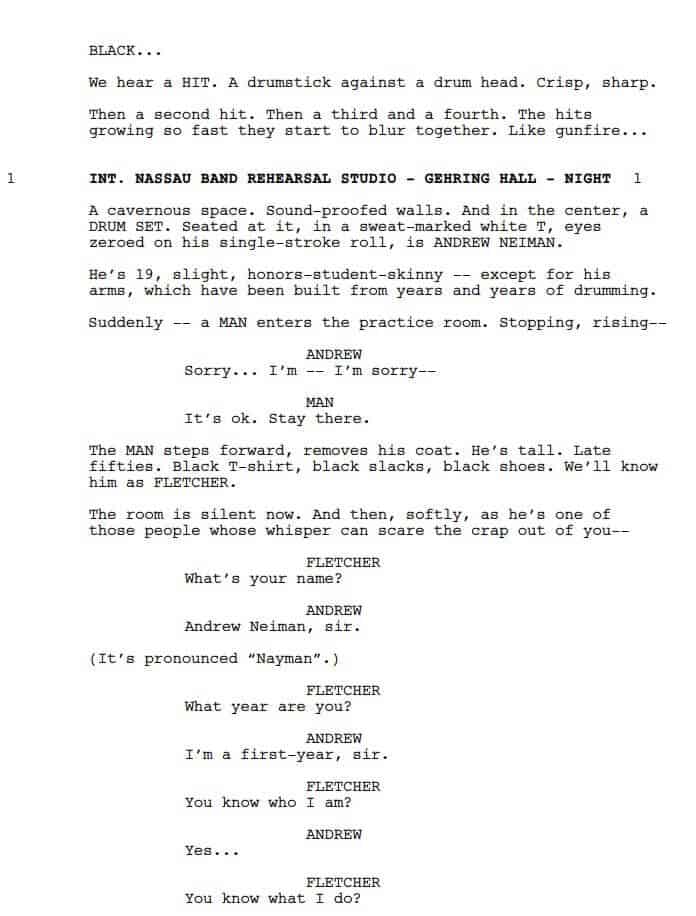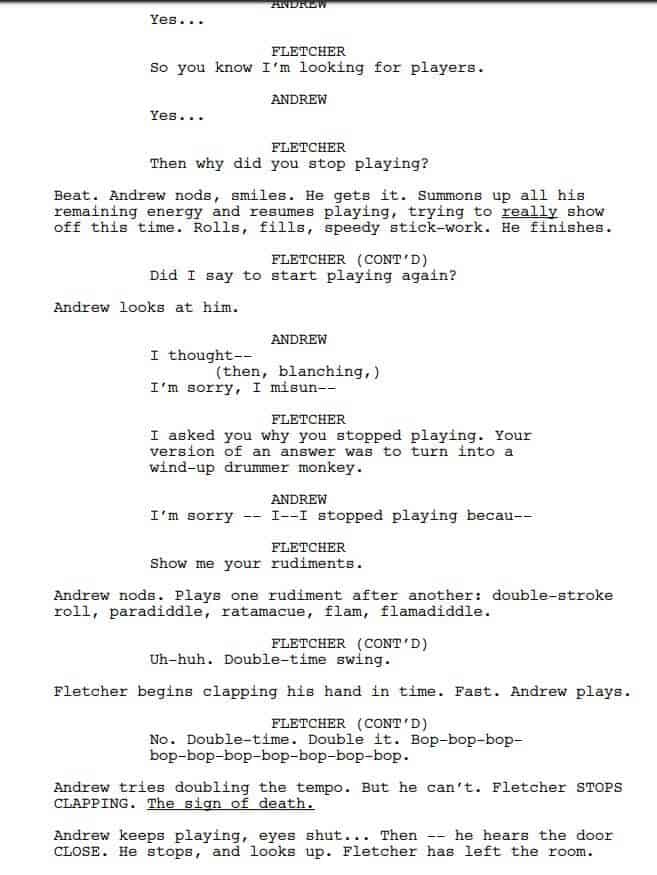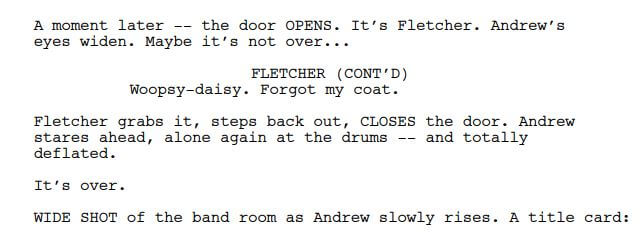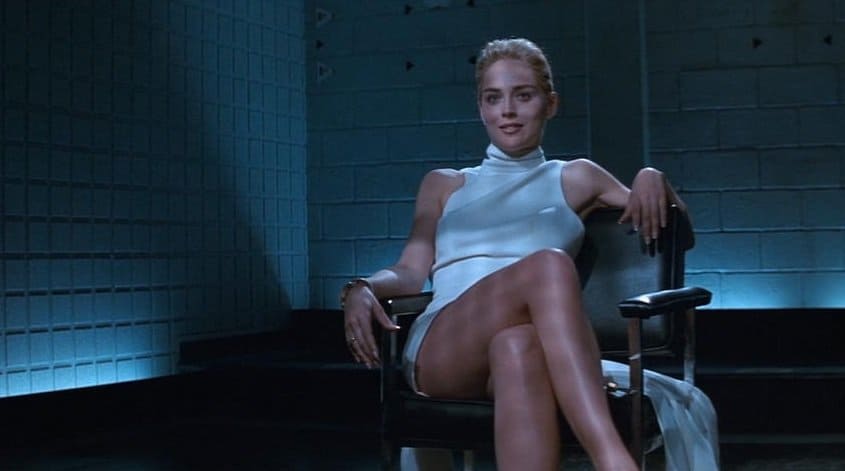The scene is the second to the smallest unit of a script with a beat being the smallest. Most people can imagine a story most can write a plot few can write a good scene.
According to the Story export David Mamet, you can write a scene with three questions:
- Who wants what from whom?
- What happens if they don’t get it?
- Why now?
If you remember anything from this post if you don’t answer these three questions in your scene. You don’t have a scene you have an event.
In this post, we are going to break down the elements of a good scene and use some examples from popular movies as evidence of these elements. But first…
What is a Scene?
A scene is a series of actions sometimes happening in one location by a character to complete an attempt to accomplish their main goal.
A good example of this is in “Catch me if you can” a movie about a cop chasing a scam artist. The scene below shows when the main characters Carl played by Tom Hanks, almost caught Frank played by Leonardo Decaprio.
Location: Hotel room
Characters Main goal: Catch Frank
Actions: Carel Finds Frank
Frank plays like a cop
Carel is slowly convinced
Frank gets away
Now if Carl catches Frank, the movie is over. If your protagonist gets to there goal, then the movie is over. Let’s leave that for the last scene in the movie.
Now we’re all caught up to what a scene is let break down step by step elements of one.
One Main Goal (every scene needs one)
The goal of the scene sometimes called the purpose is the reason your protagonist is there. Again it’s the attempt to accomplish or complete their objective. Nothing more, nothing less.
There are two types of goals internal and external.
Internal Goals
Anything that the character is looking for within there self. For example, happiness, joy, purpose, appreciation, etc. These types of goals are sometimes harder to visualize but easier to explain. Most of the time, they are found through trying to achieve some type of external goal.
External Goals
For example, a job, a girl, a relationship, money, material items, etc. These are easier to explain and visualize because we can physically see them. A million in the bank is more visual than someone’s slow rise to happiness.
All most all of the time you need some form of both. Maybe your character is looking for the relationship but realizes he’s happier by herself. The protagonist wants appreciation, so he thinks obtaining financial wealth would get him there. Having both will not necessarily add complexity to your story but will add depth.
Depth is what we seek complexity just requires more exposition to explain.
For example, think about the movie The Martian the 2015 fantasy drama about an astronaut who was accidentally left behind on a mission to Mars. What’s the main character’s external goal? To get back home. This is what the whole movie is based off. But we are deeper than that. people need more.
What’s the internal goal to fight against loneliness.
Watching most heavy action movies they fail to have an internal goal for there character. Which on some mental level makes us not appeal to the movie as much. And ultimately we don’t remember the movie at all unless someone brings it up.
Now with that said film directors can present these goals in different ways, sometimes hiding them for one reason or another but they are always there.
You can think of each scene as if it was its own movie — first act, second act third act. But at the end of this movie, we don’t know the complete answer yet just peace of it.
Each scene is its own miniature movie.
With its own goals both internal and external. Let’s look at a scene from Whiplash a movie about a young drummer in a music school trying to win a spot on one of the toughest teachers bands.
Break down both internal and external goals fo the scene.
Location: Band room
Characters main external goal: Impress the teacher Characters main internal goal: Stay calm Actions: Andrew gets a chance, Andrew messes up, Teacher gets angry, Andrew breaks down
Now as you can see from this example the Andrew character doesn’t accomplish his goals. Most of the time you don’t want them to accomplish anything. If he does the story is over. You can roll the credits at that point.
Bottom Line
Write down the point of the scene which is the reason your protagonist is there. Take note of the internal goals and external goals. Make sure you have both within your scene to add depth.
One Main Want (Every character needs one)
Each character in your script wants something. Keep track of what that is because every action they take will drive them closer to that want. Or if it doesn’t at least, they will think the action will.
For example, watch the scene below from Inglorious bastards.
Hanz Landa played by Christoph Waltz is a Nazi Soldier who finds missing jews. By the of the scene, ask yourself what does he want?
If you WANT to win the war tonight, we have to make a deal?
What does he want? The end to the war and to be done with it. They want the same thing as well.
Now unlike this example for a scene to work, you only need one character to want something. Not everyone needs to have a plan if they did most short films wouldn’t work.
Conflict a lot fo the time Stakes all the time
Conflict is one of the essential parts of any story. Most stories, not just screenplays, have conflict. Think about every story you grew up hearing weather; it is Disney or a bedtime story; they all had some type of conflicting element to them. The same goes for each scene in your script.
Toy story one conflict comes in when Woody is afraid of being replaced by Buzz. We are reminded in almost every scene. It’s ok to have the same conflict jump from scene to scene. It actually makes for a better movie.
Having multiple conflicts in a film can be done but having four different conflicts in a movie can confuse the audience on what’s most important.
Start with the conflict end with conflict. It’s very important for the audience. People are there to watch struggle not to complete happiness.
What is the conflict in films?
Conflict in movies are the struggles stopping your character from reaching their goal. Sometimes called obstacles. And just like goals, they can be internal and external.
External Conflict
For example, it can be a person, a bomb, a sword, a country, an army, etc. Think of things that will physically stop your character from achieving their goal.
The struggle there character has that is holding them back from their main goal. For example, most likely a personality flaw, or a lack of knowing oneself.
Just like goals again to create depth, we must have both.
What are the stakes in the film? And why it’s sometimes more important than conflict.
Stakes are the consequences and repercussions of not obtaining one’s goal. They set the importance in the audiences head about why something needs to happen. For example, read these three completely made up scene ideas and tell me which is better.
Jane needs to study for her test, or she will fail the class.
Jane needs to study for her test, or she will fail highschool.
Jane failed her test, so she’s going to break into the school tonight before grades are posted tomorrow. Change her grade in her teacher’s computer before she fails highschool and gets rejected from Harvard.
The third one sounds more interesting because the consequences of not accomplishing the goal are high. The higher the stakes, the better without getting too ridiculous shes doesn’t need to go to space to change her grades or anything.
Bottom Line
Conflict are the obstacles of the scene. Without it, the scene becomes boring to the audience. Start your scene with conflict end it with more conflict. Stakes are the consequences, adding Stakes are important for us yo know why it’s important for the character.
Reveal Information
Remember when writing scenes to reveal a little more information that the audience didn’t know before. This keeps people interested in what’s going to happen next. Without this slow drip of information, films get stale.
Without it, films get stale. Whether your giving clues to a big reveal at the end like M. Knight Shyamalan or your just keeping us until we can get to the next scene like Tarantino something must be given to keep our attention
What new information is presented?
Anything really but generally we learn more about the character. Revealing plot details or exposition is also done, but you don’t want to give away everything too soon. Doing this can get the audience to jump ahead of the script and guess the ending within the first 15 pages.
Make sure its a slow enough drip of information that keeps readers wanting more but fast enough that people don’t get bored. Each script calls for a different pace of this please use script readers to help judge.
When can you ignore this rule?
The last scene of the movie
The last scene of the movie is presented when all the cards are on the table; there are no more bread crumbs. Only then can you decided to ignore this.
During action scenes
A lot of the time, action scenes are a result of new information given in the previous scene or an explosion of all the information tied together. When this happens most of the time, people don’t care about new information they want to see that major fight.
With these two examples given this doesn’t mean you can’t still present key information during these moments. It’s actually better if you do but if you decide not to it won’t is the death of your script.
Bottom Line
Give more information than you had last time. Ask what information are you revealing in this scene about the character and story? The only times you can ignore this rule is the last scene in the movie or during action scenes.
Advance the story Forward
Ask yourself the following questions before writing the scene and after writing.
- What happened?
- Why did it need to happen?
- Now that we know this what happens next?
Most of the time, if you follow the advice given above, you will do this naturally. But unfortunately, some screenwriters who are really excited tend to write or even worse keep scenes that think would be cool to have in a movie. Writing a script is 30% whats cool 100% story.
Of course, you want the most stylish scenes in your movie, but what comes before syle is a story. We’ve all seen useless scenes in a movie. If you think you haven’t just think of a time, you were in the theatre and got bored. Think of that time you took a bathroom break and came back not missing a beat.
This only happens because of added moments in a film that don’t push the story forward. When you come back from a concessions break at the theatre, you should be completely lost. Having to ask your friend:
“What how did they get in space.”
Audience member
Bottom Line
Keep your scenes running with the thought of what needs to happen next. And not what I want to happen next. The audience shouldn’t be able to go to the bathroom during your movie without being completely lost.
Text vs Subtext
What is Subtext?
The subtext is what is said between the lines. The actions, and the dialogue that reveal there true meaning or nature of a personal situation, etc. In other words, its what you hear and see vs. what it really means.
Characters like people don’t normally say exactly what they mean. And neither should your characters.
For example, take a look at one of Training Day’s opening scenes. What can you see about the characters subtextually?
The captain Alonzo played by Denzel Washington seems to be a tough, hard-hitting police detective that doesn’t always play by the rules.
The new guy Jake played by Ethan Hawk is a young straight shooter who wants a chance at detective.
In this scene, they set up the difference between the characters and let you know how the rest of the film was going to go. Think to yourself what are my characters going to portray in this scene how do I want the audience to feel about them. Then what could I get them to do and say to give that vibe?
Adding subtext to things like true intention gives you depth.
For more on subtext Dialogue check out my post below:
Bottom Line
Subtext is the true meaning of what is said and done by characters. Characters never reveal their true intentions.
Write less (Let us imagine the fire)
What a lot of new screenwriters do in screenplays are written to much. Over explaining every little detail and filling parenthetical lines up as if they were the director. No, no, no!
One element of creating a scene that people tend to forget that I mentioned above is to keep us wondering what happens next. By explaining everything, we can guess the ending. One technique is just to write less take your two sentences and turn it into one.
Think about what do they need to know for this scene to work and only this scene. Sometimes you want to add clues for the end of the movie. But most of the time, just give enough to make this scene work. You can always add later if it’s still confusing to your reader.
For more information on this subject and some tips on how to do this, Check out my blog post below:
Bottom Line
Writing less detail is a great way to keep people guessing about what happens next. It helps the reader turn the page.
Arrive Late Leave Early
To arrive late in a scene means to start us without any of the normal life formalities. If audiences wanted real life they would watch a documentary.
An example of dialogue like this is:
Hi, how are you?
Am I fine hows Jane?
Oh, she’s in school?
An example of an action line is:
She walks down the stairs into the bedroom, checks out the furniture finds nothing.
Now with that said you can have these lines in your film only if the dialogue provides subtext needed maybe how they will give you the feeling of conflict between them. Or your writing a scary movie and you need to slow down the pace with exact actions given.
But unless your leading up to something big cut it out. Think of the time you were listening to a story a friend was telling you, and you were bored through the first three minutes of it, and you just wanted the juicy details. Treat your script as if its the juicy details.
Next, don’t keep your scene running longer than the objective of it.
After the point of the scene is accomplished, we are in a new scene and need a new scene header. Dragging scenes on longer than they expect is a sure way to kill your audience’s attention.
Unfortunately, I can’t find any examples of this because these scripts almost never get made, but you will know it when you see it.
Bottom Line
Start with conflict. Don’t start with formalities unless you’re using the formalities to show subtext. The scene ends when the objective of your scene ends.
Cut Out Everything that doesn’t Matter
The fact that hes drinking a coke doesn’t matter it just doesn’t.
What shoes shes wearing doesn’t matter.
Writing every eyebrow arch doesn’t matter.
A lot of things you think is important really doesn’t matter. The only time they matter is if these things are important to the goal of the scene. Don’t write the details. Write details that help the story.
What if you want someone to appear mysterious because of there actions in the story, then the fact that they are hunched over is important to the story.
Ok, we are done with this step by step checklist from the most important things in a scene to the least important. But just because The bottom tips are less important doesn’t mean you should ignore them.
A screenplay is like your body; there isn’t one thing that keeps it ticking there are multiple things that have to be in effect at the same time.
Bottom Line
Most of the time the details you think are important aren’t important to the story. Cut out everything that doesn’t help the objective of the scene.
How to Write an Opening Scene
Now I want to prove all the steps previously mentioned apply to every type of scene even opening ones. Nothing changes.
Please read the first scene of whiplash below then watch it after we discuss everything we’ve talked about so far plus some new elements that will help your opening scene.



Now let’s watch the scene to get the full picture.
What’s the main goal of this scene?
To introduce the two main characters and to show a glimpse of there soon to be a relationship.
What does the drummer want?
To impress
What does the teacher want?
Greatness
What information do we reveal?
The teacher is hard to impress. The student wants to prove himself
What is the subtext?
From the very beginning, we can see that the drummer works hard and probably has little to no friends. You get this feeling from the shots and the situation more than the dialogue itself. But this is all written as you can see.
Did we come into the scene late and left early?
The music teacher literally came late and left early.
Your opening scene literally sets the pace for the movie; without it, Everyone will be lost.
How to Write a Scene Between Two People
Again nothing changes from the checklist above. Remember all the points in this post and you should be able to write a scene between any amount of people.
But in a scene between two people, you have to be hyper-aware of actions and dialogue. Especially the more isolated these people are. Your audience is going to be looking for more when you give them less. Two people talking in one room alone requires more detail than two people talking and walking on a busy street.
The second tip is to never forget what they want from each other. They must always want something from the other person or they wouldn’t be talking to each other. The want and the obstacles need to be in every scene but they can’t be any questions on what that specifically is in this type of scene.
This fact doesn’t always take place in real life but in movies its a must. What doesn’t the person wants from the other? Start with that and end with that and your scene will be better than most newer screenwriters out there.
Bottom Line
Same rules apply from this entire post. Be hyper-aware showing what they want from each other/
Conclusion
Please remember the steps to building a great scene:
Step 1 Write down the main goal (internal and external)
Step 2 Write down what the characters want in the scene (internal and external)
Step 3 Start with conflict end with conflict.
Step 4 Keep the stakes as high as possible.
Step 5 Reveal information (Character or plot)
Step 6 Characters often don’t say what they want out loud. It’s often the meaning behind the words.
Step 7 Write less ( Cut out what you don’t need for the story)
Step 8 Advance the story
Happy Writing.

